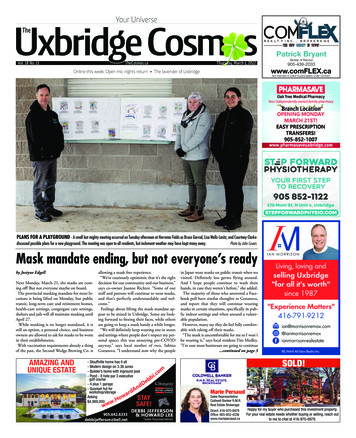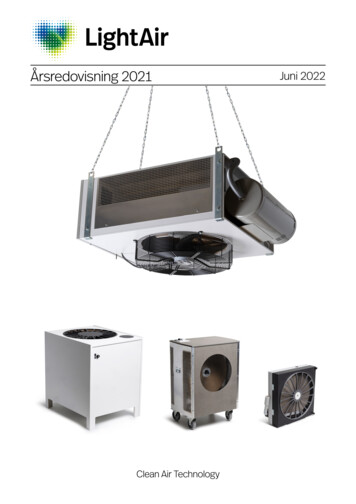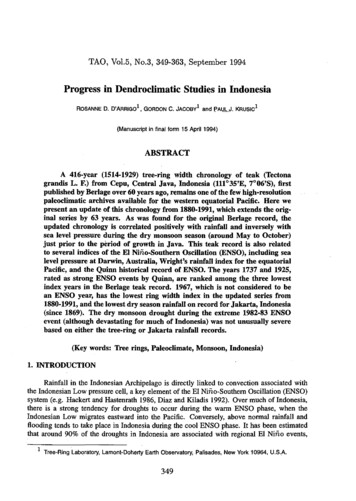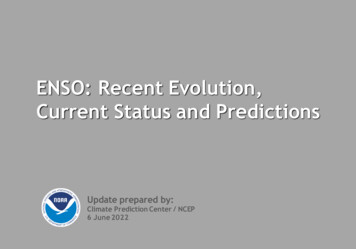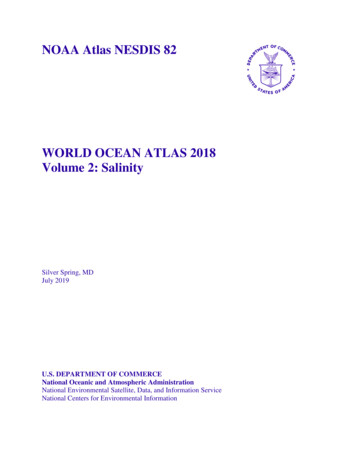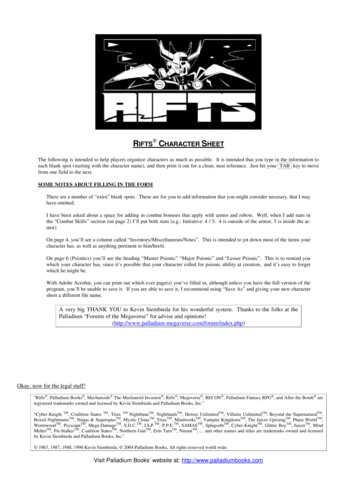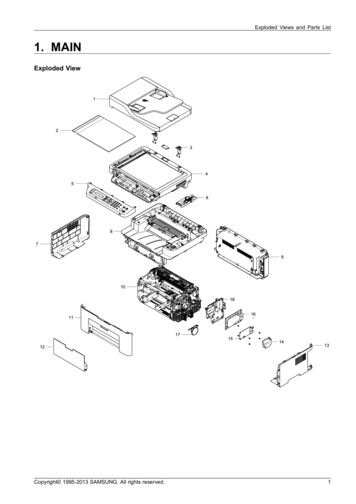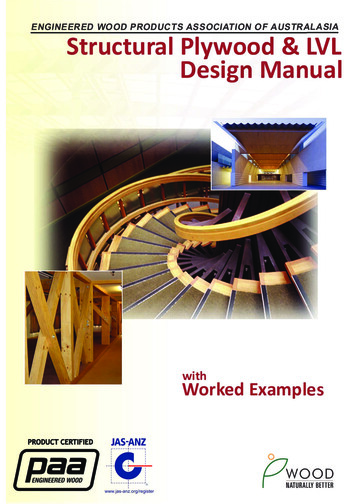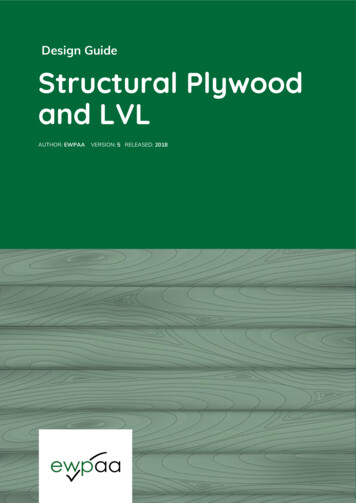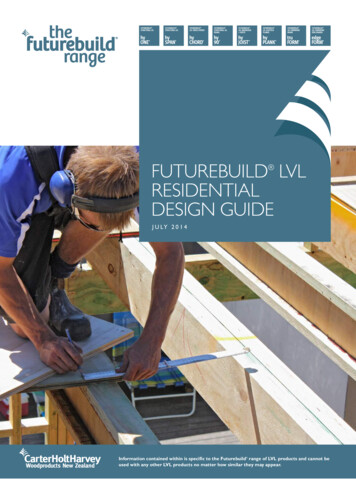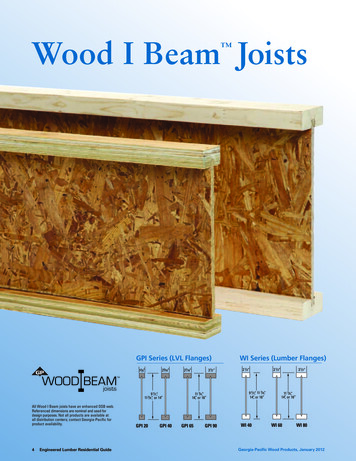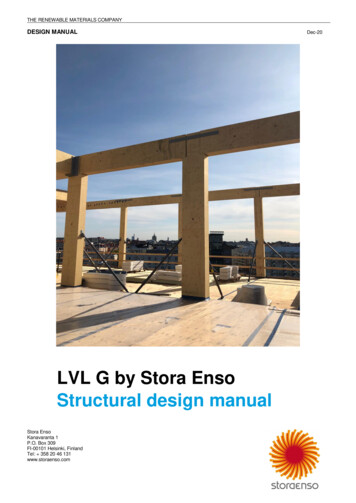
Transcription
THE RENEWABLE MATERIALS COMPANYDESIGN MANUALLVL G by Stora EnsoStructural design manualStora EnsoKanavaranta 1P.O. Box 309FI-00101 Helsinki, FinlandTel: 358 20 46 131www.storaenso.comDec-20
LVL G by Stora EnsoDESIGN MANUALTable of Contents1.Product description . 51.1Basic product information . 51.2LVL G dimensions . 61.3Cross sections . 72.Material . 92.1Stiffness and strength properties . 92.2General . 112.3Intended use . 112.4Mechanical resistance and stiffness . 113.Creep and duration of load . 113.1Partial factor for the material . 113.2Partial safety factors for loads and load combinations . 113.3Factors accounting for the load duration and moisture content. 123.4Dimensional stability . 133.5Durability . 133.6Size effect parameters . 144.Design principles . 144.1Ultimate limit states principle . 144.2Design values . 144.3Member axis of LVL G . 155.Ultimate Limit States . 165.1Bending parallel to the grain . 165.1.1 Flatwise bending strength . 165.1.2 Edgewise bending strength . 185.1.3 Bending stress . 195.2Bending perpendicular to the grain . 205.2.1 Flatwise bending strength . 205.3Tension parallel to the grain . 215.3.1 Tensile strength . 215.3.2 Tensile stress and verification . 215.4Tension perpendicular to the grain . 225.4.1 Edgewise tensile strength . 225.4.2 Flatwise tensile strength . 225.4.3 Tensile stress and verification . 235.5Compression parallel to the grain . 235.5.1 Compressive strength . 235.5.2 Compressive stress and verification . 245.6Compression perpendicular to the grain . 255.6.1 Edgewise compressive strength . 255.6.2 Flatwise compressive strength . 255.6.3 Compressive stress and verification of bearing pressure strength . 265.6.4 Effective spreading length of a supported and loaded beam member . 285.6.5 Effective spreading length of a point discretely supported and loaded member . 325.7Bending stress at an angle to the grain . 345.8Compressive and tensile stress at an angle α to the grain . 345.8.1 Compression strength at an angle to the grain . 345.8.2 Verification of compressive stress at an angle α to the grain . 355.8.3 Tension at an angle to the grain . 355.9Stability of LVL G members . 365.9.1 Members subjected to combined bending and axial compression or tension . 36THE RENEWABLE MATERIALS COMPANYPage 2 of 98Dec-20
LVL G by Stora EnsoDESIGN MANUAL5.9.2 Oblique bending . 365.9.3 Buckling of LVL G columns subjected to either compression or combinedcompression and bending . 375.9.4 Lateral torsional buckling of LVL G beams subjected to either bending orcombined bending and compression . 405.10 Shear parallel to the grain . 425.10.1 Flatwise shear strength . 425.10.2 Edgewise shear strength . 435.10.3 Shear stress and verification . 445.11 Shear perpendicular to the grain . 455.11.1 Flatwise shear strength : Rolling shear . 455.11.2 Shear stress and verification . 456.Tapered beams . 466.1Single tapered beams . 466.2Double tapered beams. 496.2.1 Climate action on double‐tapered beams . 517.Notched beams . 528.Holes in edgewise beams . 538.1Geometric boundary conditions . 538.2Size and location of the holes . 558.3Verification of the tension perpendicular to grain (approach of Ardalany) . 568.3.1 due to pure shear . 568.3.2 due to pure bending . 578.3.3 Beam subjected to combined shear and bending moment (Splitting) . 588.3.4 Fracture energy rate GI, f in mode I (opening) . 588.4Verification of shear stresses for circular and rectangular holes in beams . 588.5Verification of longitudinal stresses- Bending . 599.Connections with fasteners in LVL G’s edge and wide face . 619.1Fastener angles, spacings, edge and end distances . 629.1.1 Laterally loaded fasteners in wide and edge faces . 629.1.2 Axially loaded fasteners . 629.1.3 Minimum spacings, end distances and edge distances . 639.2Nailed connections. 669.2.1 Laterally loaded nails . 669.2.2 Axially loaded nails . 679.3Bolted and doweled connections . 679.3.1 Laterally loaded bolts or dowels . 679.4Screwed connections . 689.4.1 Laterally loaded screws . 689.4.2 Axially loaded screws. 709.4.3 Tension screwed connection . 7110. Serviceability Limit States . 7310.1 Deflection . 7310.2 Vibration . 7511. Safety in case of fire . 7811.1 Reaction to fire . 7911.2 Resistance to fire of LVL G based on calculations according to EN 1995-1-2:2011(Eurocode 5) . 7911.3 Verification method for actions in the fire situation according to EN 1995-1-2:20118011.4 Verification method for mechanical resistance in the fire situation according to EN1995-1-2:2011 . 81THE RENEWABLE MATERIALS COMPANYPage 3 of 98Dec-20
LVL G by Stora EnsoDESIGN MANUAL11.5 Charring rates of LVL G by Stora Enso . 8111.5.1 Design value of charring rates for LVL G on surfaces which are unprotectedthroughout the duration of the fire . 8211.5.2 Design value of charring rates for LVL G on surfaces which are initially protectedfrom exposure to fire by gypsum plasterboard . 8411.5.3 Start of charring on initially protected components . 8611.5.4 Failure time of fire protective claddings . 8711.6 Determining the load-bearing capacity (R) of LVL G elements according to EN1995-1-2:2011 . 8811.6.1 Reduced cross-section method . 8911.7 Structural analysis in fire . 9012. Seismic evaluation . 9113. Installation . 9113.1 Protection against temporary moisture exposure of structural LVL G . 9113.2 Resistance against UV radiation . 9113.3 Recommendations on packaging, transport and storage maintenance,replacement and repair . 9114. Annexes . 9214.1 Multi axial stresses. 9314.2 Beams with tapered edge . 96References. 97THE RENEWABLE MATERIALS COMPANYPage 4 of 98Dec-20
LVL G by Stora EnsoDESIGN MANUALPage 5 of 98Dec-20Posts & BeamsThis design manual focuses on LVL G post and beam elements.A separate design manual for LVL G panel elements will be available for design guidance.1. Product description1.1Basic product informationStora Enso Glued laminated LVL (LVL G) is covered by the ETA 20/0291 [1].It is comprised of structural Laminated Veneer Lumber (LVL) components bonded together with a PUR adhesive attheir flatwise surfaces. The adhesive used is approved for gluing of load-bearing structures and suitable for gluingof Stora Enso LVL. The adhesive used in manufacturing of Stora Enso LVL G is of type I (full exposure to theweather) as defined in EN 15425.The LVL laminations are manufactured according to EN 14374 without finger or other end joints and are calibratedto standard thicknesses. The veneers of the LVL are peeled from spruce softwood.Figure 1:LVL G section typesThere are several types of products that all are manufactured according to the same principles.THE RENEWABLE MATERIALS COMPANY
LVL G by Stora EnsoPage 6 of 98DESIGN MANUAL1.2Dec-20LVL G dimensionsGuidelines for LVL G panel dimensions are presented in Table 1 .The maximum size of the LVL G master panels are:Type L:600 mm x 2 500 mm x 19 900 mm (beams, columns and slab elements)Stora Enso LVL G Flatwise or Edgewise sections:Beams with rectangular cross section. The beams are glued of LVL S grade or X-grade and can be used edgewiseor flatwise. Typical cross sections are shown in Figure 2. The thickness of laminations can be from 24 to 69 mmwhile the width of the laminations may be from 100 to 2500 mm.Calibrated laminations 30, 36, 42, 48 and 60 mm are used for the standard manufactured product and standardwidth are also available from 200mm to 600mm as described in Table 1: Standard dimensions of Stora Enso LVLG. When used in edgewise bending, the components may have uniform height, or they may be single or doubletapered. Openings are allowed to be taken for Type B in accordance with the design instructions in chapter 8.Width hThickness bLength L 2 500mm50 – 600 mm 19 900 mmFlatwise sectionEdgewise sectionFigure 2: LVL G flatwise and edgewise cross sectionsTHE RENEWABLE MATERIALS COMPANY
LVL G by Stora EnsoPage 7 of 98DESIGN MANUAL1.3Dec-20Cross sectionsTable 1: Standard dimensions of Stora Enso LVL GCalibrated lamella thicknesses [mm]b[mm] b1 b2 b3 b4 b5 b6 b7 b8 b9 04860606030 3042484236604230484260364860424860486060604236 364230484260364860424860486060604230 30 30 304842 423648604248604860606036 36 36484248604860606042 424848 486060 6060 60 60Height / Width 600600600600600 Intended use: beam and column elements, edgewise and flatwiseMaterial: LVL-S and LVL-XMultiple glued with lay-up Type L (with all layers in longitudinal direction)o Optimal lamella thicknesses 33/39/45/51/63mm Master panel sizes (see Figure 3)o Thickness 84mm to 600mmo Width: 2 500 mm (2 520mm on request) (beams, columns and slab elements): Type Lo Width: 2 500 mm (wall elements): Type C (covered in another design manual dedicated to LVLG panels)o Length from 6m up to 19.9 mTHE RENEWABLE MATERIALS COMPANY
LVL G by Stora EnsoDESIGN MANUALPage 8 of 98Dec-20Figure 3: Example of LVL G masterpanel type L - LVL layers. Colours: first outer layer (blue), inner layer (gray), second outerlayer (green).Figure 4: Slab cross section of LVL G by Stora Enso type L.THE RENEWABLE MATERIALS COMPANY
LVL G by Stora EnsoDESIGN MANUALDec-202. Material2.1Page 9 of 98Stiffness and strength propertiesFigure 5: Definition of the strength and stiffness orientationsTHE RENEWABLE MATERIALS COMPANY
LVL G by Stora EnsoPage 10 of 98DESIGN MANUALDec-20Table 2: Characteristic and mean values of Stora Enso LVL G-S and LVL G-X grade to be used in estrengthEdgewise, parallel to the grainfm,0,edge,kfm,0, flat,kfm,90, ,31,3N/mm²L-0,6N/mm²ADG13 80010 500N/mm²B12 40010 100N/mm²ADG11 6008 800N/mm²B11 2008 800E90,flat,meanN/mm²C-2 000E90,flat,kN/mm²C-1 700E90,edge,meanN/mm²H-2 -2 0Flatwise, parallel to the grainSize effect edgewiseSize effect flatwise bendingParallel to the grainPerpendicular to the grain, flatwisePerpendicular to the grain, edgewiseParallel to the grain- Service class 1Parallel to the grain- Service class 2Perpendicular to the grain, edgewisePerpendicular to the grain, flatwiseShearstrengthEdgewise, parallel to the grainFlatwise, parallel to the grainFlatwise, perpendicular to the grainMean, parallel to the grain, edgewiseMean, parallel to the grain, flatwiseChar, parallel to the grain, edgewiseModulus ofelasticityChar, parallel to the grain, flatwiseChar, Bending perpendicular to thegrain, flatwiseMean, Bending perpendicular to thegrainMean, perpendicular to the grain,edgewiseChar, perpendicular to the grain,edgewiseMean, edgewise, parallel to grainChar, edgewise, parallel to grainShearmodulusChar, flatwise, parallel to grainMean, flat, parallel to grainMean, flat, perpendicular to grainChar, flat, perpendicular to grainDensity(1)LVL G-XUnitSize effect flatwise shearTensilestrengthLVL G-SDesignationFlatwise, perpendicular to the grainSize effectparameterFigureDirectionMean densityChar densityLVL 24-69mmlaminationWhen edgewise bending property in 90 direction is not defined, ft,90,edge,k value should be used as fm,90,edge,k .fv,0,edge,k fv,90,edge,k (Edgewise shear strength fv,0,edge,k is valid for 90 direction too. It is unnecessary practiceto have “0” in the index for the edgewise value. Only in flatwise shear, the direction 0 or 90 matters.)(2)THE RENEWABLE MATERIALS COMPANY
LVL G by Stora EnsoDESIGN MANUALPage 11 of 98Dec-20These values are based on declared values given in reports: Varkaus 2020-04-08 DoP LVL by Stora Enso, S grade, thickness 24-75mm Varkaus 2017.02.16 DoP LVL by Stora Enso, X grade, thicknesses 24-69mm VTT analysis reports VTT-S-05550-17 [2] and VTT-S-05710-17 [3] Report no EUFI29-19002201-T1 [4] and Report no EUFI29-19002201-T2 [5]2.2GeneralThe design of LVL and LVL G members according to Eurocode 5 requires strength values of the primary LVL aswell as size effect parameters “s”. For LVL loaded edgewise in bending and parallel to grain in tension, EN1995-11 gives a size effect parameter s 0,12 and a reference depth href 300 mm for edgewise bending and a referencelength Lref 3000 mm for tension, respectively.For flatwise bending, compression parallel or perpendicular to grain, tension perpendicular to grain or shear no sizeeffect parameters are given in Eurocode 5 for primary LVL. According to draft EAD DP 130337-00-0304 [6] sizeeffect parameters are required for bending strength (edgewise and flatwise), tension strength parallel to grain, andshear strength (flatwise). While for edgewise bending and tensile strength parallel to grain the size effect parameterof LVL is directly applicable to LVL G, size effect parameters for flatwise bending and shear strength (flatwise andedgewise) need to be determined.2.3Intended useStora Enso LVL G is intended to be used as a non-structural or structural element for load-bearing applications inbuilding and civil engineering structures. With regard to moisture behaviour of the product, the use is limited toservice classes 1 and 2 as defined in EN 1995-1-1.Composite action of the parts is achieved by adhesive bonded joints. Mechanical connectors are not used to achievethe composite action of the parts, but nails or screws between the parts may be used in order to achieve the pressureneeded for a proper glue bond. In Stora Enso case, pressing is used. Therefore, cross sections of Stora Enso LVLG are allowed to be handled as monolithic.Design shall be carried out according to EN 1995-1-1 and EN 1995-1-2. Strength and stiffness values of Stora EnsoLVL G given in Table 2 shall be used in the design.2.4Mechanical resistance and stiffnessThe LVL G by Stora Enso products are manufactured according to an individual design or delivered as standardproducts. In case of individual production, the design can be made on a case by case basis by the manufacturer orby a third party according to the design instructions of the manufacturer. Strength values of Stora Enso LVL G tobe used in design together with information of the dimensions of the components are given in Table 1 and Table 2.The design instructions of the manufacturer have been reviewed by Eurofins Expert Services . In case of updating,the new versions shall be approved by Eurofins Expert Services Oy.3. Creep and duration of load3.1Partial factor for the materialFor LVL partial safety factor is according to EN 1995-1-1:𝛾𝑀 1.2Exception: if national annex of EN 1995-1-1 is overruling this value.3.2Partial safety factors for loads and load combinationsThe design value Ed for the effects of actions shall be calculated using EN 1990 and its national annexes.Partial factors for loads, load combinations and for different consequence classes are taken from the appropriatenational annex.THE RENEWABLE MATERIALS COMPANY
LVL G by Stora EnsoPage 12 of 98DESIGN MANUAL3.3Dec-20Factors accounting for the load duration and moisture contentThe moisture content and the load duration shall be taken according to the appropriate national annex.The modification factors for strength k mod and deformation kdef shall be according to EN1995-1-1 and the applicableNational annex. A recommendation is given in the tables below.In Table 4, values for kmod and inTable 5, values for kdef can be found.Table 3: Load-duration class and load types.Load-duration classAction time of the loadLoadPermanentMore than 6 monthsSelf-weight, imposed load Category EMedium-term10 minutes - 6 monthsImposed floor load, snowShort termLess than 1 weekSnowInstantaneusBelow 10 minutesWind, accidental loadEffects of duration of load are taken into account according to EN 1995-1-1. The following kmod values apply inservice classes 1 and 2 for both Stora Enso LVL S grade and Stora Enso LVL X-grade component parts:Table 4: Strength modification factor kmod.Load-duration classService classPermanent actionMedium term actionShort term actionInstantaneous action10.600.800.901.1020.600.800.901.10In calculation of the final deflection, creep is considered according to EN 1995-1-1. The following deformation factorskdef shall be used:Table 5: Values of the deformation factor kdef.Service classLVL-X edgewiseLVL-S edgewiseLVL-S flatwiseLVL-X flatwise120.600.800.801.00The values in the second row are used only for flatwise bending and flatwise shear deformation of LVL X. Otherwisethe Kdef of LVL-X has the same values as for LVL S.The service classes are defined in the standard EN 1995-1-1.Service class 1 means that the structure is in warmed in-doors conditions where the moisture content correspondsmainly to a temperature of 20ºC and the relative humidity of air exceeds 65% only for a few weeks per year.Service class 2 is characterised by a moisture content in the materials corresponding to a temperature of 20 Cand the relative humidity of the surrounding air only exceeding 85 % for a few weeks per year.Deformation factor kdef is a factor to evaluate creep deformation.THE RENEWABLE MATERIALS COMPANY
LVL G by Stora EnsoPage 13 of 98DESIGN MANUAL3.4Dec-20Dimensional stabilityTolerances of dimensions for Stora Enso LVL G and swelling and shrinkage values for Stora Enso LVL G are givenin Table 6 andTable 7.The swelling and shrinkage behavior due to change in moisture content of LVL lamination relates to the swellingand shrinkage behavior of the base material.When manufactured, the moisture content of the components is below the equilibrium value in use conditions. Dueto changing temperature and relative humidity of the surrounding air the moisture content of Stora Enso LVL G willcontinuously change.The swelling and shrinkage values for Stora Enso LVL products in % per % change of moisture content are givenin Table 6. They shall be used to determine the dimensional changes of Stora Enso LVL G.Table 6: Swelling and shrinkage coefficients in different direction of Stora Enso LVL G in % per % change of moisture content.Type of timber andspeciesSwelling and shrinkage in percent per percent change of moisture content [7]In the direction of thethicknessIn the direction of the lengthIn the direction of the widthLVL-S (spruce)0,300,010,31LVL-X (spruce)0,440,010,033Table 7: Tolerances of Stora Enso LVL G.DimensionSize [mm]Tolerance [mm] or [%]Overall width b 400 400All 2 mm 0,5 % 3 mmOverall length LAll 5 mmOverall depth hCross sections of Stora Enso LVL G are in general symmetrical or almost symmetrical thus minimizing any effectsof moisture changes to overall shape of the cross section. No distortion of the cross sections is expected innormal use conditions.Effect of varying moisture content to the nominal dimensions is normally negligible and within the tolerances givenin Table 7.3.5DurabilityThe adhesive of type I can also be used in service class 3 but the untreated Stora Enso LVL flange and webmaterials do not withstand attacks from fungi. Thus, Stora Enso LVL G can be used in service classes 1 and 2according to EN 1995-1-1, and hazard classes 1 and 2 as specified in EN 335. The product may be exposed to theweather for a short time during installation.Risk of mold growth can occur in service class 2 without surface treatment.Durability may be reduced by attack from insects such as long horn beetle, dry wood termites and anobium inregions where these may be found.THE RENEWABLE MATERIALS COMPANY
LVL G by Stora EnsoPage 14 of 98DESIGN MANUAL3.6Dec-20Size effect parametersThe effe
DESIGN MANUAL Dec-20 THE RENEWABLE MATERIALS COMPANY Posts & Beams This design manual focuses on LVL G post and beam elements. A separate design manual for LVL G panel elements will be available for design guidance. 1. Product description 1.1 Basic product information Stora Enso Glued lam
